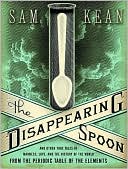

 |

|

The average rating for The Disappearing Spoon: And Other True Tales of Madness, Love, and the History of the World from the Periodic Table of the Elements based on 2 reviews is 3.5 stars.
Review # 1 was written on 2010-08-10 00:00:00 Joseph Stephens Joseph StephensStop the search. Recall the teams. I have found the non-fiction, summer read of 2010! The Disappearing Spoon. First, what's a summer read, Mr. Josey Wales thumbnail photo? A summer read is one you can enjoy during a vacation to the beach, with fresh cocktails and clean towels provided by the swarthy, bronzed attendant at a seafront hotel. You can finish it in a few days in bite-sized chunks, it doesn't overpower you academically, you learn a little, and the subject is something entirely new to you, which allows you to 'escape' mentally just as you are physically from that 50-hour, weekly cubicle career and hateful commuter traffic. The book catalogues the 200 year history of the piecemeal development of the periodic table in chemistry. Wait, this is not your high school chemistry class! Sam Kean uses the most idiosyncratic, unusual, serendipitous, and funny events to tell this story. You learn as much about the brilliant, boisterous, bi-polar, bastardly, and braggadocio scientists as you learn about each element on the periodic table. Each of 19 chapters pulls together several periodic elements and outlines their unexpected similarity and relatedness--atomically, quantumly and culturally. And the narrative moves fluidly back and forth through time to capture the relevant history of each element. The book highlights discoveries that are still being made, current as of late 2009. Strontium, Molybdenum, Ruthenium, Francium, Ytterbium. Neptunium, Berkelium, Californium, Lawrencium. What are you all about? How were you discovered? Why are you so important? And why the heck are you so rare? This is neat science told in a fun and effervescent way. There are some awesome, awe-inspiring, and yet sometimes pedestrian, elements out there. Science ofttimes moves forward in jumps and spurts, and Kean is quick to relate how it moves chaotically, unexpectedly, bizarrely, and accidentally. The author reviews not just core chemistry but also history, physics, cosmology, and psychology. The scientists and their Rube Goldberg experiments are as interesting as the results. Periodic elements are really cool (yes, I actually said that). They're phenomenal, toxic, powerful, rare, ephemeral, magical, radioactive, and have the most interesting relationships to each other. We're told why, when, and how they've been used and abused through history, and how they shepherded great leaps in the advancement of human civilization. The Disappearing Spoon is quick, light reading out in the sun. It handles complex theory in a comfortable, approachable way. Kean uses good rhythm in the book, chapters of uniform length, and a bit of humor to bring it all home. He pulls it off effectively--Mr Wizard meets chaos theory. Sixth grade, mall, 'wow'-science is discussed right next to the paragraph about how to produce absolute zero or 35 million degrees, both of which, incidentally, are created by lasers. In the end, you'll learn a little, laugh a little. You may not remember anything from this book 2 years from now, but you will retain this: elements are neat as hell, and thank goodness for chemists and physicists. New words: depilatory, eluted |
Review # 2 was written on 2012-01-06 00:00:00 Ben Maikan Ben MaikanMy GR friend Jason writes sturdy and trustworthy reviews, but I must take exception with him here : The Disappearing Spoon is quick, light reading out in the sun. It handles complex theory in a comfortable, approachable way. Yes, it is all that, IF such stuff as this makes sense to you : The strongest solo acid is still the boron-based carborane (HCB11C111) And this boron acid has the best punchline so far : it's simultaneously the world's strongest and gentlest acid. To wrap your head around that, remember that acids split into positive and negative parts. In carborane's case you get H+ and an elaborate cagelike structure formed by everything else (CB11C111-) With most acids it's the negative portion that's corrosive and caustic and eats through the skin. But the boron cage forms one of the most stable molecules ever invented. Its boron atoms share electrons so generously that it practically becomes helium, and it won't go around ripping electrons from other atoms, the usual cause of acidic carnage. Well, this could be part of the rules of Quidditch for all the sense it makes to poor general reader me, so I think The Disappearing Spoon is really for science geeks who think stuff about German chemists being hornswoggled out of a Nobel Prize for Alchemy by some Californian sharpies in 1951 or a neat account of the crucial properties of the biomolecule which are called handedness is the very thing for those moments on the beach when there isn't any eye candy around. |
CAN'T FIND WHAT YOU'RE LOOKING FOR? CLICK HERE!!!